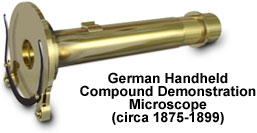German Handheld Compound Microscope
This late-nineteenth-century compound microscope is a handheld demonstration model, most likely crafted in Germany. The basis for the illustration featured below is the description and photograph of the original unsigned instrument provided by Gerard Turner in his book entitled Catalogue of Microscopes.

The brass instrument consists of an oval end plate attached to a cylindrical outer sleeve, which covers the length of a 180-millimeter long body tube. On the free side of the brass plate, a horseshoe-shaped clip is attached that can be used to hold specimens in place. Focusing of the microscope may be accomplished directly by either pushing or pulling the end plate towards or away from the eyepiece, or indirectly via a tab attached to the body tube that rides in a slot along the outer sleeve. For illumination, the microscope is solely dependent upon sunlight or ambient light transmitted through the circular aperture of the end plate since it lacks mirrors, Lieberkühn reflectors, condensers and other light-gathering optics.
During scientific lectures and other types of natural history demonstrations that were popular during the late Victorian period, microscopes such as this one were passed around the room with a mounted specimen for the audience's viewing pleasure. When not in use, however, this compound microscope may safely rest horizontally on two feet and the eyepiece housing. The original handheld device is currently part of the extensive microscope collection housed in the Institute and Museum of the History of Science in Florence, Italy.
BACK TO NINETEENTH CENTURY MICROSCOPES
